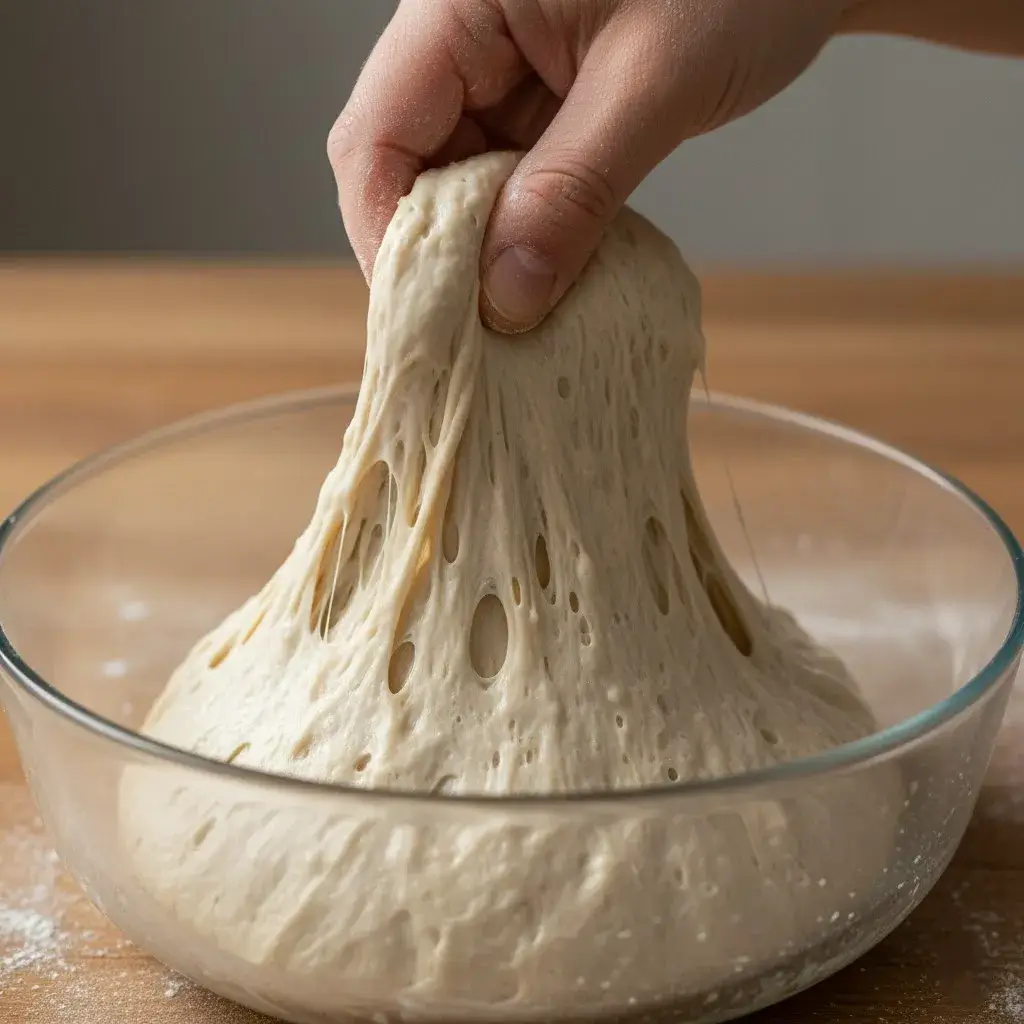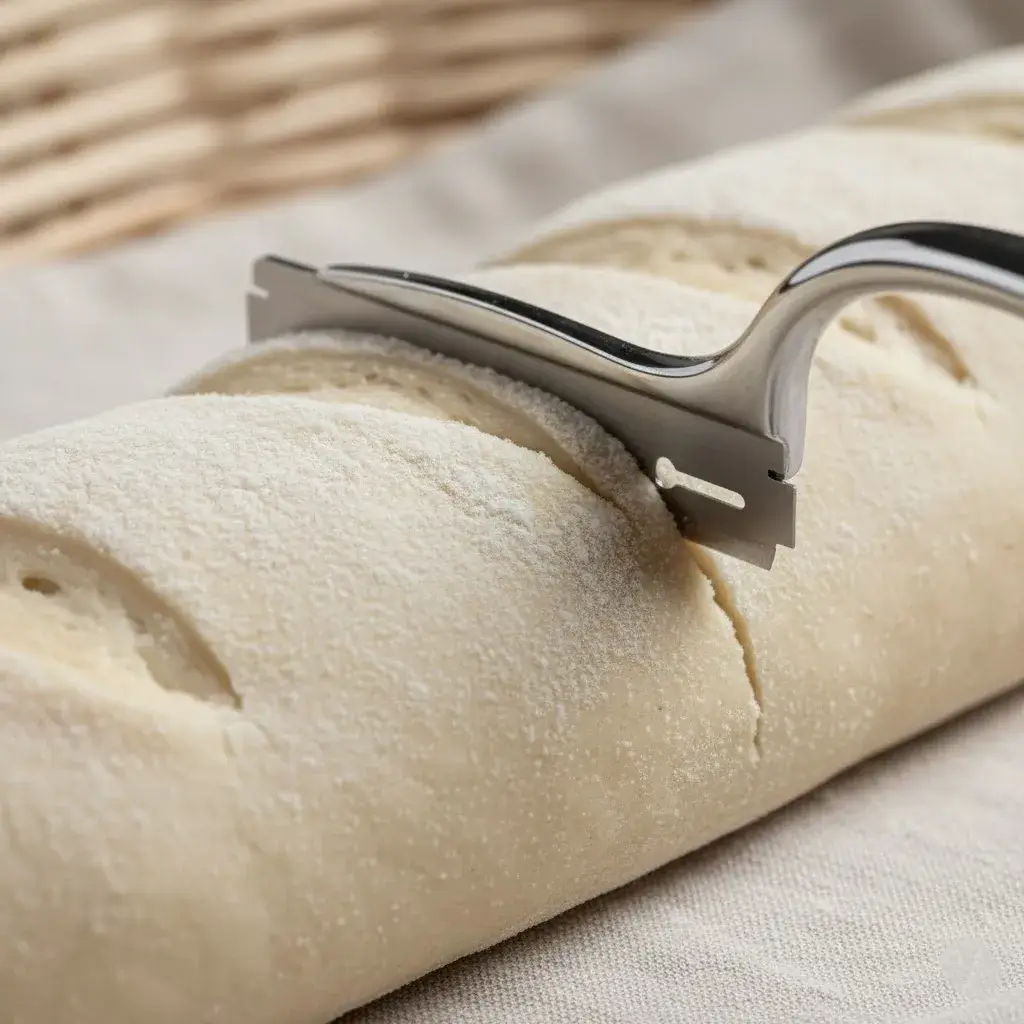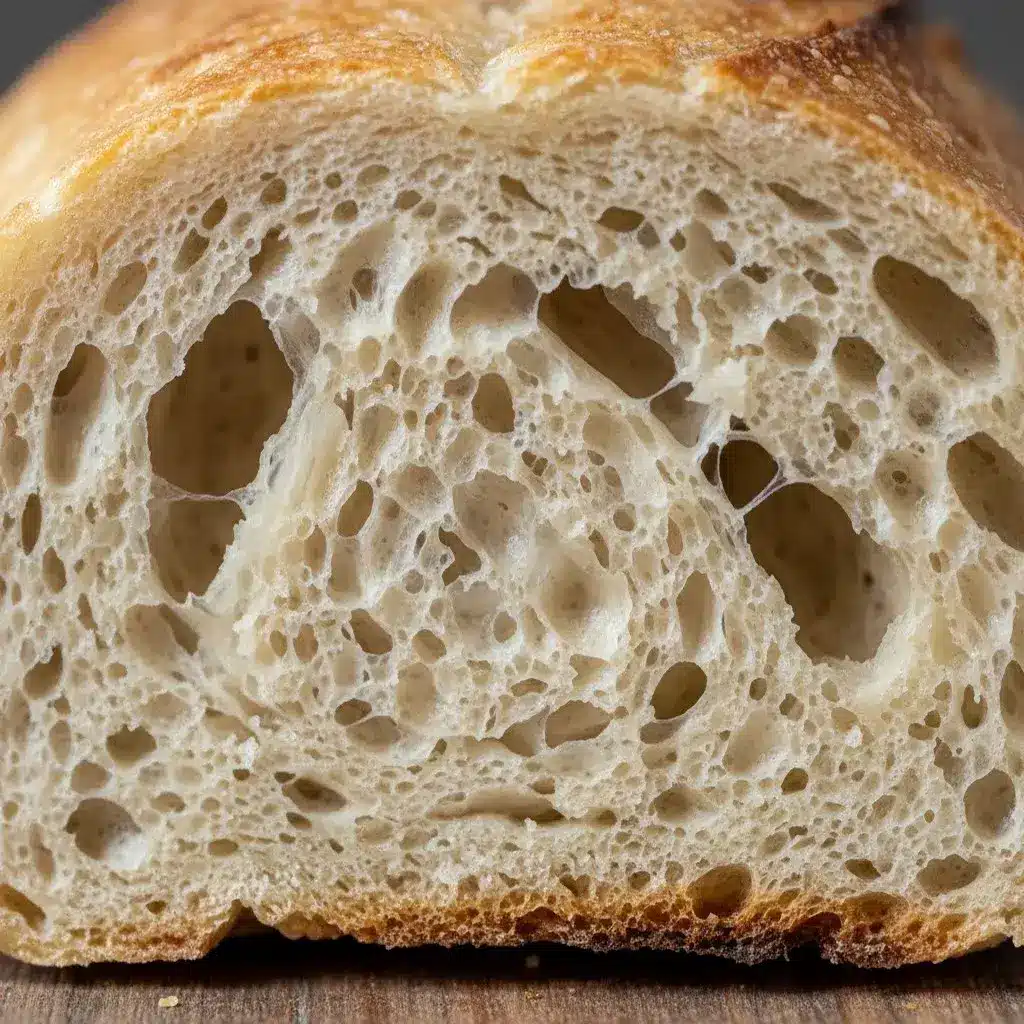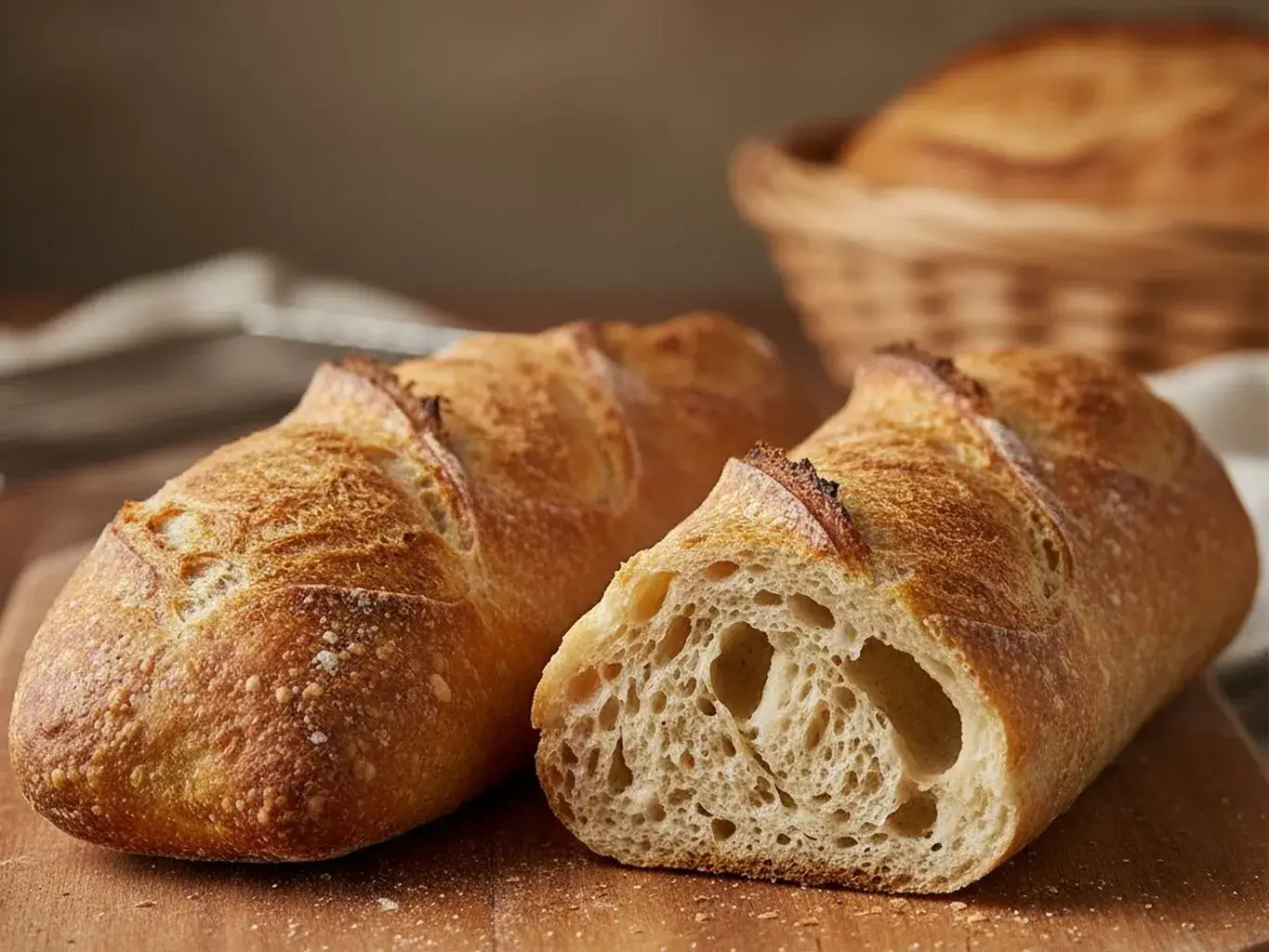This authentic Sourdough Baguette Recipe elevates the classic French loaf. Made with a natural sourdough starter instead of commercial yeast, they boast a deliciously crunchy crust and an open, airy crumb that’s light yet perfectly chewy. They deliver all the complex flavor and sought-after qualities of the perfect artisanal baguette.
While it may seem like a feat reserved for professional Parisian bakers, I’m here to show you that with a little patience and this trusted sourdough baguette recipe, you can achieve bakery-quality results in your own kitchen. This Sourdough Baguette Recipe strips the process back to its beautiful essentials flour, water, salt, and your lively sourdough starter to create a loaf that is not just bread, but a true experience.
WHY THIS SOURDOUGH BAGUETTE RECIPE IS A GAME-CHANGER
This Sourdough Baguette Recipe is designed for the home baker who craves authenticity without unnecessary complexity.
- First, it uses a straightforward method with clear, manageable steps, demystifying the process of shaping and scoring.
- Secondly, the extended, slow fermentation driven by your sourdough starter develops an incredible depth of flavor that yeast-based baguettes can’t match.
- Furthermore, the steam-baking technique we’ll use is the ultimate secret to achieving that professional, shattering crust.
- Finally, the pride of pulling your own golden, blistered baguettes from the oven is a feeling of accomplishment that store-bought bread can never provide.

SOURDOUGH BAGUETTE RECIPE
- Total Time: 16 hours 25 minutes
- Yield: 2 baguettes 1x
- Diet: Vegan
Description
A classic sourdough baguette with a crisp crust, chewy interior, and tangy flavor perfect for sandwiches or serving with cheese and butter.
Ingredients
- 500g bread flour
- 350g water (room temperature)
- 100g active sourdough starter (100% hydration)
- 10g salt
- Extra flour for dusting
Instructions
- 1. In a large bowl, mix the starter and water until dissolved.
- 2. Add flour and mix until a shaggy dough forms. Cover and rest for 1 hour (autolyse).
- 3. Sprinkle salt over the dough and mix by hand until well incorporated.
- 4. Perform stretch and folds every 30 minutes for 2 hours, keeping the dough covered between sets.
- 5. After the final fold, let the dough rest until doubled in size (about 3–4 hours depending on temperature).
- 6. Gently turn the dough onto a floured surface and divide into two equal portions.
- 7. Shape each portion into a baguette by flattening slightly, folding the sides inward, and rolling tightly into a log.
- 8. Place shaped baguettes on a floured couche or parchment-lined tray, seam side up. Cover and refrigerate overnight.
- 9. The next day, preheat the oven to 475°F (245°C) with a baking stone or steel and a steam pan inside.
- 10. Score the baguettes with a sharp blade, then bake with steam for 20–25 minutes until golden brown.
- 11. Cool completely on a wire rack before slicing.
Notes
- Use an active, bubbly starter for best results.
- If your kitchen is cold, fermentation may take longer. Be patient.
- To create steam, add a cup of hot water to the steam pan just before closing the oven door.
- Prep Time: 16 hours
- Cook Time: 25 minutes
- Category: Bread
- Method: Baking
- Cuisine: French
Nutrition
- Serving Size: 1 slice (60g)
- Calories: 150
- Sugar: 0g
- Sodium: 200mg
- Fat: 0.5g
- Saturated Fat: 0g
- Unsaturated Fat: 0.5g
- Trans Fat: 0g
- Carbohydrates: 31g
- Fiber: 1g
- Protein: 5g
- Cholesterol: 0mg
Keywords: sourdough, baguette, artisan bread, homemade
THE FOUR PILLARS OF A PERFECT SOURDOUGH BAGUETTE RECIPE
Understanding the core principles behind this sourdough baguette recipe will make you a more confident baker. It all rests on four key elements:
- Crust: A crackling, crisp crust is achieved through high heat and steam during the first part of baking.
- Crumb: An open, airy, and chewy interior (the crumb) comes from a well-developed gluten network and gentle handling.
- Flavor: The complex, slightly tangy flavor is a direct result of a long, slow fermentation with an active sourdough starter.
- Shape: The iconic long, thin shape with elegant scores (lames) is not just for looks; it controls how the bread expands in the oven.
YOUR SIMPLE, PURE INGREDIENT LIST
True artisan baking requires nothing more than the best ingredients you can find.
For the Baguettes:
- 500g Bread Flour
- 350g Water, room temperature
- 100g Active, Bubbly Sourdough Starter
- 10g Fine Sea Salt
THE BAKER’S TOOLKIT
While you can make do with basics, a few tools are incredibly helpful:
- Digital Kitchen Scale (non-negotiable for accuracy)
- Bench Scraper
- Banneton Proofing Basket or a couche (linen cloth)
- Razor Blade or Lame for scoring
- A baking stone or steel (highly recommended)
- A pan for creating steam (like a cast iron skillet)
THE JOURNEY TO BAGUETTE PERFECTION: A STEP-BY-STEP GUIDE
This process is a labor of love spread over a day. Embrace the slow pace; it’s where the magic happens.
STEP 1: CREATE THE DOUGH (AUTOLYSE)
In a large bowl, combine the 500g of bread flour and 350g of water. Mix with your hands or a spatula until no dry flour remains. This initial rest, called the autolyse, lasts for 30-60 minutes. It allows the flour to fully hydrate, making the dough easier to work with and improving its final structure.
STEP 2: INCORPORATE THE STARTER AND SALT
After the autolyse, add the 100g of active sourdough starter and 10g of salt to the bowl. Use wet hands to pinch and fold the dough until the starter and salt are fully incorporated. The dough will be sticky and shaggy at this stage.
STEP 3: BULK FERMENTATION & STRETCH & FOLDS
This is the primary rise. Over the next 3-5 hours (depending on your kitchen’s temperature), you will perform a series of “stretch and folds.” Every 30 minutes for the first 2 hours, wet your hand, grab one side of the dough, stretch it upwards, and fold it over the center. Repeat for all four “sides” of the dough. This gently develops the gluten without vigorous kneading. Let the dough rest for the remainder of the bulk ferment until it has increased by about 30-50% and is full of air pockets.

STEP 4: DIVIDE AND PRESHAPE
Turn the dough out onto a lightly floured surface. Gently divide it into two equal pieces using your bench scraper. Preshape each piece into a loose round by folding the edges into the center. Let them rest on the counter, covered, for 20-30 minutes. This relaxes the gluten for final shaping.
STEP 5: SHAPE THE BAGUETTES
Lightly flour your work surface. Take one dough round and gently press it into a rectangle. Fold the top third down to the center and press gently to seal. Fold the bottom third up to the center and seal again. Now, starting from the top, roll the dough down tightly to create a seam. Using gentle pressure, roll the dough back and forth to elongate it into a baguette about 14-16 inches long.

STEP 6: FINAL PROOF
Heavily flour a couche (linen cloth) or a tea towel. Place the shaped baguettes seam-side up into the folds of the couche to support them. Cover and let them proof for 1-3 hours at room temperature, or for a more pronounced sour flavor, proof in the refrigerator for 12-16 hours. They are ready when the dough feels airy and a small indentation slowly springs back.
STEP 7: PREHEAT AND SCORE
At least 45 minutes before baking, place your baking stone/steel on a middle rack and a cast iron skillet on the bottom rack. Preheat your oven to 475°F (245°C). When ready to bake, carefully turn one baguette onto a piece of parchment paper. Using a razor blade (lame), make 4-5 long, diagonal slashes along the top at a shallow angle. This is scoring, and it allows the bread to expand beautifully in the oven.

STEP 8: BAKE WITH STEAM
Carefully slide the baguette (on the parchment) onto the preheated baking stone. Immediately pour 1 cup of hot water into the preheated cast iron skillet below to create a burst of steam. Bake for 15 minutes with steam. Then, remove the skillet of water, and continue baking for another 15-20 minutes until the baguettes are deeply golden brown and sound hollow when tapped on the bottom.
PRO TIPS FOR BAKING NIRVANA
Elevate your bread from great to extraordinary with these simple tricks.
- Use a Scale: Baking by weight is essential for consistency in hydration and results.
- Active Starter is Key: Your starter should be at its peak, having doubled in size 4-8 hours after its last feeding.
- Don’t Rush the Proof: The final proof is complete when the dough feels light and airy, not when the clock says so. The poke test is your best friend.
- Sharp Scoring: A very sharp blade or lame is essential for clean, ear-raising scores. A dull knife will tear the dough.
TROUBLESHOOTING: YOUR QUESTIONS ANSWERED
“My baguettes are dense with no holes.”
This is usually due to under-proofing, an inactive starter, or over-handling the dough during shaping. Ensure your starter is very active and give the dough enough time to rise.
“My crust isn’t crispy.”
You likely didn’t have enough steam in the oven. The initial steam is crucial for keeping the crust soft long enough for the bread to spring up, then it crisps as it finishes baking.
“My baguettes spread out flat instead of rising up.”
The dough was likely over-proofed or under-developed. It may have been too wet for your flour. Ensure you develop enough gluten strength with your stretch and folds.
“My scoring didn’t open up.”
Your blade was likely at too steep of an angle. Hold it almost parallel to the surface of the dough for the best “ear.”
A NOTE ON THE BAKER’S JOURNEY
Sourdough is a practice, not a perfect science. Your first loaves are a learning experience. Embrace the process, take notes, and with each bake, you’ll get closer to your ideal baguette. The journey is as rewarding as the destination.
MY STORY: A PARISIAN DREAM IN MY KITCHEN
My quest for the perfect sourdough baguette recipe began after a life-changing trip to Paris. I became obsessed with recreating that specific texture and flavor at home. After countless flat, dense, and pale attempts, the moment I pulled a batch from the oven that actually sounded right, that iconic crackle, I nearly cried.

The first bite, with its chewy, tangy crumb, transported me right back to a sidewalk café along the Seine. It was a testament to the fact that with patience and practice, the most iconic baked goods are within our reach.
YOUR FINAL BAKING CHECKLIST
Before you begin, run through this list:
- Sourdough starter is active, bubbly, and has recently doubled.
- All ingredients are weighed, not measured with cups.
- Baking stone/steel and cast iron skillet are in the oven preheating.
- You have a razor blade ready for scoring.
- You have set aside the time; this cannot be rushed.
SOURDOUGH BAGUETTE RECIPE FAQS
Can I use all-purpose flour instead of bread flour?
You can, but the baguettes will have less chew and a more tender crumb, as bread flour has a higher protein content for better gluten development.
How do I know if my starter is active enough?
It should reliably double in size within 4-8 hours of a 1:1:1 feeding (starter:flour:water) and be full of bubbles.
Why is my sourdough not sour?
A longer, cooler final proof (in the refrigerator) will develop more acetic acid, which gives sourdough its characteristic tang.
Can I halve this sourdough baguette recipe?
Absolutely! Simply halve all the ingredients. The process and timing remain the same.

